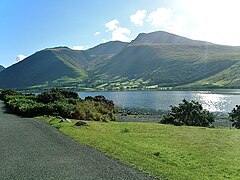2012 Summer Paralympics torch relay
 | |
| Host city | London, United Kingdom |
|---|---|
| Countries visited | United Kingdom |
| Start date | August 22, 2012 |
| End date | August 29, 2012 |
| Torch designer | Edward Barber and Jay Osgerby |
 |
| Part of a series on |
| 2012 Summer Paralympics |
|---|
|
|
The 2012 Summer Paralympics torch relay ran from 22 to 29 August 2012, prior to the 2012 Summer Paralympics. The relay began with four flames kindled on the highest peaks of the four nations of the United Kingdom, which were then brought to their respective capital cities for special events honouring the upcoming Games. For the relay proper, the four national flames were united at a ceremony in Stoke Mandeville in preparation for a final 92-mile (148-kilometre) journey to London.[1]
Relay
Journey to Stoke Mandeville
The Paralympic torch relay began on 22 August. In a ceremony representing human endeavour, groups of disabled and non-disabled scouts kindled the four Paralympic flames on the highest peaks of each nation of the United Kingdom; Scafell Pike in England, Ben Nevis in Scotland, Slieve Donard in Northern Ireland, and Snowdon in Wales. The four flames were then brought down from each peak in lanterns. On 24 August the flames were used to light ceremonial cauldrons in their respective capital cities (London, Edinburgh, Belfast and Cardiff) during "Flame Festival" events. A total of 38 towns and cities also hosted "Flame Celebration" events over the bank holiday weekend, where community representatives collected a part of their nation's flame to bring back for their respective events.[2][3][4]
- Scafell Pike
-
 Ben Nevis
Ben Nevis - Slieve Donard
-
 Snowdon
Snowdon
Journey to London

On 28 August a ceremony was held at Stoke Mandeville Stadium, in honour of Stoke Mandeville's significance to the Paralympic movement, where the four national flames were united in a cauldron at precisely 8:12 pm (20:12) to form a single flame for the relay. The four flames were brought into the stadium by dignitaries, including English model Katie Piper (who began to campaign for burns victims after having acid thrown in her face in 2009)[5] and Scottish amateur boxer Jonjo Look (who had a leg amputated and replaced by a prosthesis following an accident filling a gas canister).[6][7]
The flame travelled a 92-mile (148-kilometre) route to the Olympic Stadium in a 24-hour relay, with 580 torchbearers working in teams of five. It travelled through iconic areas of London such as Abbey Road and London Zoo.[2] Poor weather caused a two-hour delay on the Wednesday before the Games; parts of the route were modified to help ensure it would reach the stadium in time, while a backup flame was taken straight to the stadium as a contingency.[8] However, as the opening ceremony's parade of nations took longer than expected, the flame was able to arrive at Olympic Stadium in time.[9]
End of relay
The final three torchbearers represented three generations of Paralympic athletes. The torch entered the Olympic Stadium via a zipline attached to ArcelorMittal Orbit, carried by Joe Townsend, a former Royal Marine with amputated legs. Townsend represented the future as an athlete planning to compete in 2016 Summer Paralympics, a plan that came to fruition when he represented Great Britain in triathlon in Rio. He passed the torch to David Clarke, long-time captain of Britain's Five-a-side football team, representing the present. With his guide, Clarke passed the torch to Margaret Maughan, the winner of Great Britain's first gold medal at the 1960 Summer Paralympics, representing the past.[9]
Route in the UK
- August 24
- 01. London
- August 25
- 02. Belfast
- August 26
- 03. Edinburgh
- August 27
- 04. Cardiff
- August 28
- 05. Stoke Mandeville
- August 29
- 06. Olympic Stadium













